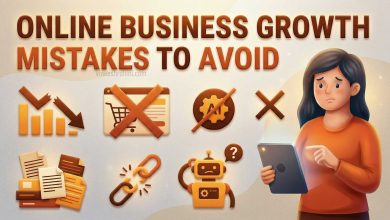Online Food Business

Online Food Business: In today’s fast-paced, digitally driven world, the food industry has seen a dramatic shift towards online business models. The convenience and accessibility of ordering food online have transformed the way people dine and interact with food services. This essay aims to provide a comprehensive guide on how to start and successfully run an online food business. Throughout this essay, we will repeatedly emphasize the importance of the “online” aspect of the food business, as it plays a pivotal role in the modern food industry landscape.
Online Food Business – a Comprehensive Guide
Table of Contents
1: Identifying Your Online Food Business Niche
Before delving into the intricacies of starting an online food business, it is crucial to identify your niche within this dynamic industry. Your niche will determine your unique selling proposition (USP) and set you apart in the online marketplace.
When selecting your niche, consider the following:
- Market Research: Conduct extensive market research to identify trends, gaps, and opportunities in the online food business landscape. Understand your target audience and their preferences.
- Passion and Expertise: Choose a niche that aligns with your passion and expertise. Your genuine interest will drive your business’s success.
- Competition Analysis: Analyze the competition within your chosen niche. Identify what sets you apart and how you can offer a better online experience.
2: Crafting Your Online Food Business Plan
Once you’ve identified your niche, it’s time to develop a solid business plan tailored to the online food industry.
Here are key components of your business plan:
- Business Concept: Clearly define your business concept. What will your online food business offer that others don’t? Articulate your value proposition.
- Market Analysis: Dive deep into your target market. Understand the demographics, psychographics, and behavior patterns of your potential customers.
- Business Model: Choose the right business model for your online food business. Will you act as an intermediary connecting producers and consumers, or will you create and sell your own food products exclusively online?
- Financial Projections: Develop detailed financial projections, encompassing startup costs, revenue forecasts, and a break-even analysis. This is crucial for securing funding and ensuring a financially viable venture.
3: Legal and Regulatory Considerations
Operating an online food business requires compliance with various legal and regulatory requirements. Ensure you are aware of and adhere to these regulations:
- Business Structure: Select an appropriate legal structure for your online food business, such as a sole proprietorship, limited liability company (LLC), or corporation.
- Permits and Licenses: Research and secure the necessary permits and licenses to operate legally. This includes food handling permits and health department certifications.
- Food Safety Compliance: Implement and maintain food safety practices in accordance with local, state, and federal regulations. Training your staff in safe food handling is imperative.
4: Building Your Strong Online Presence
Your online presence is your digital storefront. Building a robust online presence is critical to attracting and retaining customers in the online food business.
- Domain and Website: Choose a memorable domain name and invest in a well-designed, user-friendly website. Your website is where customers will explore your offerings, place orders, and interact with your brand.
- E-commerce Platform: Implement a reliable e-commerce platform to facilitate smooth online ordering and secure payment processing.
- Mobile App Development: Consider developing a mobile app to enhance the user experience. Many customers prefer the convenience of ordering from a dedicated app.
Also Read : How to Promote Your Homemade Food Business Online – Online Food Business
5: Marketing and Branding Strategies
Effectively marketing your online food business is essential for attracting and retaining customers. Your branding efforts should consistently emphasize the online aspect of your business.
- Branding: Develop a strong and memorable brand identity. Ensure that your branding resonates with your target audience and communicates your online presence.
- Social Media Marketing: Leverage social media platforms to promote your online food business. Engage with your audience, showcase mouth-watering visuals, and run targeted advertisements to reach potential customers.
- Search Engine Optimization (SEO): Optimize your website for search engines to improve your online visibility. This includes keyword research, on-page SEO, and off-page SEO strategies.
- Content Marketing: Create valuable content related to food, recipes, and culinary tips. Share this content on your website and social media channels to establish yourself as an authority in your niche.
Buy Now : Affiliate Program Plugin for WordPress & WooCommerce
6: Sourcing Ingredients and Suppliers
The quality of your ingredients is crucial to the success of your online food business. Sourcing them efficiently is essential.
- Local Sourcing: Explore options for sourcing ingredients locally whenever possible. This not only supports the local economy but also reduces transportation costs and environmental impact.
- Supplier Relationships: Build strong relationships with reliable suppliers. Consistent and high-quality ingredients are the backbone of your online food business.
7: Online Food Production and Delivery
Efficient food production and reliable delivery are vital components of your online food business.
- Commercial Kitchen: Establish a commercial kitchen or partner with a certified kitchen for food production. Ensure it complies with food safety regulations.
- Packaging and Delivery: Invest in sustainable and appealing packaging for your food products. Provide multiple delivery options, including contactless delivery, to cater to various customer preferences.
8: Customer Service and Feedback
Exceptional customer service is key to retaining customers in the competitive online food business landscape.
- Customer Support: Offer responsive customer support channels. Address inquiries, concerns, and issues promptly to build trust with your customers.
- Feedback Loop: Create a feedback loop to collect customer reviews and suggestions for improvement. Use this feedback to enhance your offerings and service.
9: Scaling Your Online Food Business
As your online food business grows, you’ll need to plan for expansion and embrace technology to stay competitive.
- Expansion Opportunities: Explore opportunities for expansion, whether by entering new markets, expanding your product range, or diversifying your online services.
- Technology Integration: Embrace emerging technologies, such as artificial intelligence and data analytics, to optimize your online operations and enhance the customer experience.
10: Adapting to Market Changes
The online food business landscape is dynamic, and staying agile is crucial for long-term success.
- Market Trends: Stay vigilant for evolving food industry trends and adapt your business accordingly. Be prepared to pivot when necessary.
- Crisis Management: Develop a robust crisis management plan to handle unexpected challenges, such as food safety issues or disruptions in the supply chain.
Tips For Online Food Business
Starting and running a successful online food business requires careful planning, dedication, and a keen understanding of the digital landscape. Here are some essential tips to help you thrive in this competitive industry:
- Nail Your Niche: Identify a specific niche within the online food business that aligns with your passion and expertise. Whether it’s gourmet cuisine, healthy meal prep, or ethnic specialties, a well-defined niche can set you apart.
- Invest in a User-Friendly Website: Your website is your online storefront. Invest in professional web design and ensure it is user-friendly, responsive, and optimized for mobile devices. Easy navigation and quick loading times are essential.
- Emphasize Food Photography: High-quality, appetizing food photography is crucial. Showcase your dishes with mouthwatering images that make visitors eager to place an order.
- Streamline Online Ordering: Implement an efficient online ordering system with secure payment processing. Make it easy for customers to browse your menu, customize their orders, and complete transactions seamlessly.
- Prioritize Food Safety: Maintain strict food safety standards in your kitchen and during delivery. Communicate these practices to your customers to build trust.
- Effective Marketing: Develop a strong online presence through social media, search engine optimization (SEO), and content marketing. Engage with your audience, share compelling content, and run targeted advertising campaigns.
- Delivery Options: Offer various delivery options, including contactless delivery, to cater to customer preferences. Ensure timely and reliable deliveries to enhance the customer experience.
- Customer Feedback: Establish a feedback loop to collect reviews and suggestions. Use this information to continuously improve your offerings and service.
- Sustainability: Embrace eco-friendly practices, such as using recyclable packaging and sourcing locally, to appeal to environmentally conscious consumers.
- Adapt and Innovate: Stay agile and adapt to changing market trends and customer preferences. Continuously innovate your menu and services to keep customers excited and coming back for more.
- Build Customer Loyalty: Implement a loyalty program to reward repeat customers. Consider offering special discounts or exclusive perks to encourage customer loyalty.
- Legal Compliance: Ensure compliance with all local, state, and federal regulations related to food handling, safety, and licensing. Stay up-to-date with changing regulations.
- Data Security: Safeguard customer data and payment information to build trust and protect your business from cyber threats.
- Customer Support: Provide excellent customer support through responsive communication channels. Address customer inquiries and concerns promptly and professionally.
- Monitor Metrics: Regularly analyze key performance indicators (KPIs) such as website traffic, order volume, and customer feedback. Use these insights to make data-driven decisions.
In the rapidly evolving online food business landscape, these tips can help you navigate the challenges and seize the opportunities. Remember that success in this industry often comes from a combination of culinary expertise, a strong online presence, and exceptional customer service. Continuously adapt and refine your strategies to stay ahead in this competitive digital marketplace.
Latest Trends in Online Food Business
The online food business has witnessed a remarkable transformation in recent years, largely driven by technological advancements, changing consumer preferences, and global events like the COVID-19 pandemic. In this essay, we will explore some of the latest trends that are shaping the landscape of the online food business.
1. Ghost Kitchens and Virtual Brands
Ghost kitchens, also known as virtual kitchens or cloud kitchens, have emerged as a disruptive force in the food industry. These kitchens are devoid of a traditional dine-in area and instead focus exclusively on fulfilling online orders for multiple virtual restaurant brands. The advantages are manifold: they reduce overhead costs, maximize kitchen space efficiency, and allow for experimentation with diverse culinary concepts without the constraints of a physical location. This trend has revolutionized the way restaurants operate, creating new opportunities for entrepreneurs and established food businesses to expand their reach and offerings.
2. Contactless Ordering and Delivery
The COVID-19 pandemic has accelerated the adoption of contactless ordering and delivery options. In response to health concerns, consumers have become more reliant on online food ordering and expect a seamless, contactless experience. Online food businesses have adapted by implementing touchless payment systems, contactless delivery methods (e.g., leaving orders at the doorstep), and enhanced sanitation protocols. This trend is likely to persist as customers prioritize safety and convenience.
3. Plant-Based and Sustainable Menus
The rise of plant-based and sustainable food options is one of the most prominent trends in the food industry. Online food businesses are increasingly offering plant-based menu items to cater to the growing demand from environmentally conscious consumers. Furthermore, sustainability has become a focal point, with businesses adopting eco-friendly practices such as sourcing local and organic ingredients, minimizing food waste, and reducing their carbon footprint. These efforts not only resonate with socially responsible consumers but also contribute to a positive brand image.
4. Personalization and AI
Artificial intelligence (AI) and machine learning are revolutionizing how online food businesses interact with customers. By analyzing customer data, including ordering history, preferences, and behavior, AI-driven systems can provide personalized recommendations. These recommendations extend beyond menu items to include promotional offers and even optimal delivery times. Personalization enhances the customer experience, increases customer satisfaction, and drives sales.
5. Meal Kits and DIY Cooking
The popularity of meal kits has surged, particularly during the COVID-19 pandemic. Meal kit services provide customers with pre-measured ingredients and detailed recipes to prepare restaurant-quality meals at home. These kits offer convenience, eliminate the need for grocery shopping, and allow consumers to explore new cuisines and cooking techniques. Online food businesses have seized this opportunity to diversify their offerings and engage with customers in a novel way.
6. Subscription Services
Subscription-based models have gained traction in the online food business. These services offer customers the convenience of regular deliveries, whether it’s curated meal plans, specialty products, or unique food experiences. Subscribers often benefit from cost savings and exclusive perks, while businesses enjoy a predictable revenue stream and improved customer retention. The subscription model aligns with the desire for convenience and the joy of discovering new culinary experiences.
7. Local Sourcing and Community Engagement
Supporting local communities and sourcing ingredients locally have become key priorities for many online food businesses. By partnering with nearby farms, artisanal producers, and food cooperatives, businesses can not only reduce their environmental impact but also build trust with customers who value the “farm-to-table” concept. Engaging with the community through sponsorships, events, and collaborations further strengthens brand loyalty.
8. Health and Wellness Focus
Health and wellness have taken center stage in the food industry. Online food businesses are increasingly offering nutritious and balanced menu options to cater to health-conscious consumers. Transparency in providing nutritional information, ingredient sourcing, and accommodating specific dietary requirements have become essential aspects of business strategy. Customers appreciate businesses that prioritize their well-being.
9. Diverse Food Delivery Options
Online food businesses are expanding their horizons beyond traditional restaurant deliveries. Many now offer delivery services for a wide range of products, including alcohol, groceries, specialty items, and even medications. This diversification transforms online food platforms into comprehensive one-stop-shopping destinations, addressing various consumer needs and preferences.
10. Social Commerce
Leveraging social media platforms for food sales has become a significant trend. Many online food businesses use features like Instagram Shopping and Facebook Marketplace to reach a broader audience and facilitate direct sales through social media. These platforms enable businesses to showcase their products, engage with customers, and provide a seamless shopping experience without leaving the social media app.
11. Digital Loyalty Programs
Digital loyalty programs have become instrumental in retaining and rewarding customers. Through mobile apps and websites, businesses can implement points-based systems, exclusive discounts, and referral programs. These initiatives incentivize repeat business and foster brand loyalty, as customers seek value and recognition for their loyalty.
12. Zero-Waste Initiatives
Minimizing food waste is a growing concern for online food businesses. To address this issue, businesses are finding innovative ways to reduce waste in their operations. This includes repurposing surplus ingredients into new dishes, implementing portion control, and donating excess food to charities. Zero-waste initiatives not only benefit the environment but also resonate with customers who value sustainability.
the online food business is a dynamic and ever-evolving industry. These emerging trends reflect the industry’s adaptability and responsiveness to changing consumer expectations and market dynamics. Staying informed and proactive in embracing these trends can position online food businesses for sustained success in a competitive and rapidly evolving marketplace. Whether it’s adopting sustainable practices, enhancing personalization through AI, or expanding into new product categories, the future of the online food business holds exciting opportunities for those willing to innovate and meet the evolving needs of consumers.
Buy Now : Affiliate Program Plugin for WordPress & WooCommerce
In conclusion, the online food business industry is thriving, and with careful planning, dedication, and a focus on the “online” aspect, you can embark on a successful entrepreneurial journey. The repeated emphasis on the online component underscores its significance in the modern food industry, where convenience and accessibility are paramount. By following the steps and strategies outlined in this guide, you can establish and sustain a prosperous online food business that caters to the evolving needs and preferences of today’s digital consumers. Remember that success in the online food business often requires continuous learning, adaptation, and a commitment to delivering exceptional online experiences to your customers.



